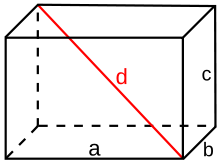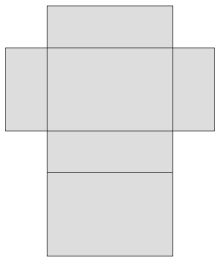Cuboid
![]()
The title of this article is ambiguous. For other meanings, see cuboid (disambiguation).
A cuboid is a geometric solid bounded by 6 rectangles.
A cuboid has
- 6 rectangular side faces that are at right angles to each other,
- 8 right-angled corners and
- 12 edges, four of which have equal lengths and are parallel to each other.
Opposite faces of a cuboid are parallel and congruent (congruent). The cuboid is a rectangular three-dimensional parallelepiped.
In the special case of equal edge lengths 




Cuboid with space diagonal d

Unfolded net of a cuboid
Symmetry
Cuboids have several symmetry properties depending on the number of equal edge lengths.
have cuboids with three different edge lengths
- 3 bidentate axes of rotation (through the midpoints of two opposite faces),
- 3 mirror planes (3 planes through four edge centers each),
- 3 rotational reflections (by 180° with the planes through four edge centers each)
cuboids with two different edge lengths (square straight prisms) have
- 1 fourfold axis of rotation (through the centers of two opposite squares),
- 2 bidentate axes of rotation (through the midpoints of two opposite rectangles),
- 3 rotational reflections (by 180° with the planes through four edge centers each)
Cuboids with only one edge length, the cubes, have more symmetries (see cubes - symmetry).
Each cuboid is
- point-symmetrical to the center M.
Formulas
| Sizes of a cuboid with edge lengths a, b, c | ||
| Volume | |
|
| Sheathing | | |
| Surface area | | |
| Circumferential radius | | |
| Space diagonal | | |
| Area diagonals | | |
| | ||
| | ||
| Volume to sphere volume ratio | | |
| Solid angle in the corners | | |
Optimization problems and the cube
There are several optimization problems for cuboids. If one is looking for a cuboid which is
- given length of the diagonal or given sphere volume the maximum surface area
- given length of the diagonal or given sphere volume the maximum volume
- given surface area the minimum length of the diagonal or the minimum volume of the sphere
- given surface area the maximum volume
- given volume the minimum length of the diagonal or the minimum sphere volume
- given volume the minimum surface area
then the solution in each case is the cube.
In each case, two of the six optimization problems are basically the same problem with other given sizes, so that there are actually only three different optimization problems. For the optimization problems mentioned, the cube is the cuboid we are looking for. Of course, this is not true for all optimization problems.
That the optimization problems for the length of the diagonal 


cuboid with the largest volume is sought for a given circumsphere radius, then the edge lengths 



Suppose that any cuboid with at least two different edge lengths, for example 













So the arbitrary cuboid with at least two different edge lengths cuboid has a smaller volume than the other cuboid. From this follows that a cuboid with at least two different edge lengths cannot have the largest volume and finally that the cuboid with only one edge length, i.e. the cube with 12 edges of equal length, has the largest volume of all cuboids with a given radius of revolution.
Decisive for this proof by contradiction is here that the volume of the cuboid must be finite, because it is obviously smaller than the volume of the circumsphere, and that the volume function is continuous.
Search within the encyclopedia











